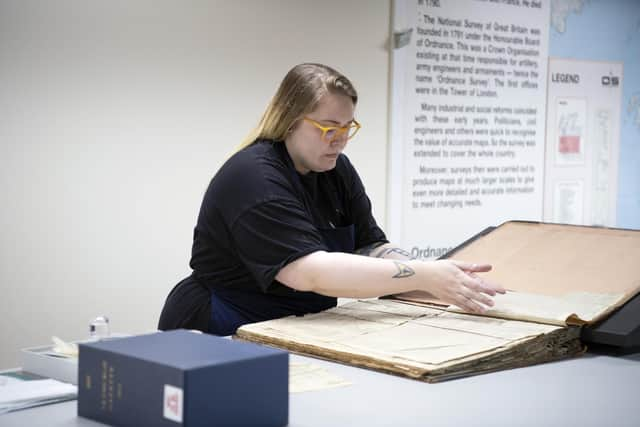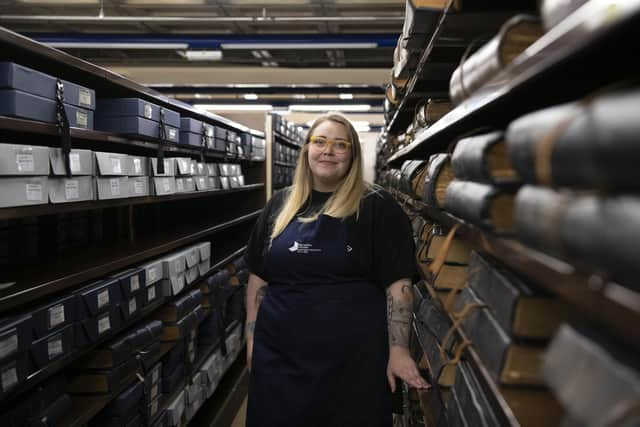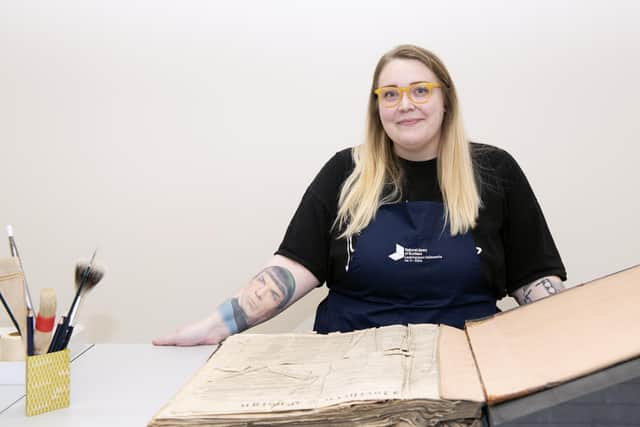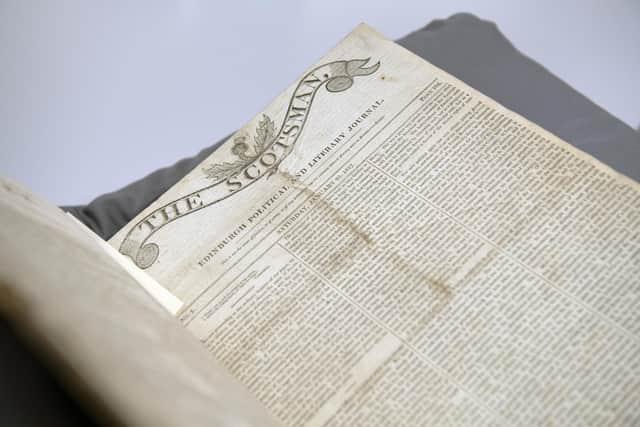Val McDermid backs new Save Our Stories appeal to secure future of ‘fragile and brittle’ newspaper treasure trove
and live on Freeview channel 276
The National Library of Scotland (NLS) say there has been “significant deterioration” of a vast treasure trove dating back to the 17th century.
It has revealed two thirds of its newspapers are under threat without “urgent intervention” to repair the publications held in thousands of crumbling volumes weighing up to 27kg.
Advertisement
Hide AdAdvertisement
Hide AdCrime writer and former journalist Val McDermid, who has drawn on the National Library's newspaper archives for her books, has agreed to spearhead a "Save Our Stories" campaign.


The National Library is hoping its supporters around the world will back an appeal aimed at helping to pay for pain-staking conservation work to be carried out on the most at-risk newspapers and for their contents to be digitised so they can be viewed online.
Experts have warned they are "fighting a losing battle" to safeguard the collections.
The National Library, which holds one of the most extensive newspaper archives in the UK, has collected them since its formation in 1925.
Advertisement
Hide AdAdvertisement
Hide AdThe archive includes 961 titles published in Scotland since 1641 when the first newspaper, the Caledonian Mercury, arrived. It includes a copy of the first edition of The Scotsman from January 25, 1817, which will being go on public display next year as part of a permanent exhibition of treasures drawn from the National Library’s entire archives.


The oldest newspapers in the NLS collection are said to be in better condition than some of the more recent ones as they were printed on paper made from old rags.
Claire Hutchison is the lone conservator carrying out the pain-staking work to conserve the newspapers in the poorest condition, including those previously held in local libraries.
This involves removing them from their original bindings, flattening, decreasing and mending scratches and tears – using reversible adhesive and fine Japanese tissue paper – and reattaching loose fragments.
Advertisement
Hide AdAdvertisement
Hide AdShe said: “Everyone knows that newsprint is not supposed to last more than a day. Older newspapers were made of rag paper, which was essentially cotton linen fibres. The paper was slightly thicker and was much better quality.


“With cheaper, more large-scale production that came from around 1900, newspapers were made from a wood pulp fibre that is inherently acidic.
"It contained an acidic component that deteriorates the paper. We’re fighting against an acidity that will never go away.
“The best approach to conserving the most fragile newspapers is to take an almost ‘first aid’ approach to try to save as much as we can. My conservtion work is about providing stability so that the pages can be digitised.
Advertisement
Hide AdAdvertisement
Hide Ad"In some cases, there is very little left of the binding and we’re trying to save as much of the newsprint as possible. Stabilising the pages saves the content and saves our history.


"The bindings have been both a blessing and a curse. They’ve protected them to some degree, but putting a whole year of newspapers in one binding has made them too heavy and too tight. There were good intentions, but they have led to a plethora of damage.”
Ms Hutchison said newspapers were by far the most-requested items to view in the National Library’s collection.
"Our archive of newspapers is by some distance the biggest in Scotland. An entire floor of our Causewayside collection centre is dedicated to them and they’re starting to creep onto other floors as well.
Advertisement
Hide AdAdvertisement
Hide Ad"But these collections are incredibly fragile and very brittle. We’re fighting a losing battle at the moment.
“The archive is extremely important from a social history and ancestry point of view. Someone wants a newspaper from us every day. That is never going to go away.
"Newspapers provide such a strong human connection that you don’t really get with anything else in our collection. It is everyone’s stories, it is our history and it is so local. Everyone can remember a newspaper that they or someone they know was in, or a time when an event happened. It is so important that we preserve them.”
McDermid has praised the National Library and its staff for help in researching the first two novels in her new series following journalist Allie Burns, which were set in 1979 and 1989 respectively.
Advertisement
Hide AdAdvertisement
Hide AdShe revealed that the next instalment of the Inspector Karen Pirie series would see a cold case investigation prompted by “an eagle-eyed librarian spotting something very odd in an archive bequeathed by a recently deceased author.”
The crime writer said: “It’s not just writers of fiction for whom the newspaper archive is a vital resource. Historians, cultural commentators, investigative journalists – they all rely on this valuable resource to paint a picture of our past as it was experienced by the people who lived it. Without it, we are poorer as a nation.”
The National Library holds around 961 of the 1750 newspaper titles which are believed to have been published in Scotland, with around 327 of the latter ceasing publication before it was established in 1927.
Titles in the National Library’s archive include The Scotsman, Edinburgh Evening News, The Press and Journal, The Herald, the Daily Record, The Sunday Post, the Ayrshire Post, the Perth Shopper, the Inverclyde Extra, Highland News, Stornoway Gazette, Orkney Today and the St Andrews Citizen.Louise McCarron, head of reader services at the National Library said: “People use our newspapers to research their family history, authors take inspiration from real-life people and events, and visitors often reminisce over photographs of their town or village changing over time.”
Advertisement
Hide AdAdvertisement
Hide AdLucy Clement, head of development at the National Library, said: “Our analysis has revealed that without urgent intervention, 65 per cent of our newspapers – and the unique stories they contain – will be lost.
“Our conservators can carry out urgent repairs to our most damaged newspapers and prepare them for digitisation, but this is an expensive process. We need donations to save these stories.”
Comment Guidelines
National World encourages reader discussion on our stories. User feedback, insights and back-and-forth exchanges add a rich layer of context to reporting. Please review our Community Guidelines before commenting.
